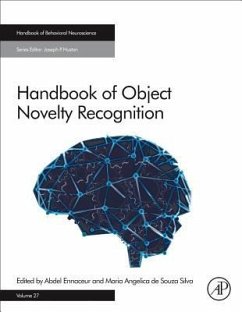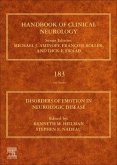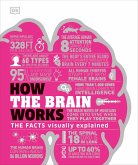Handbook of Object Novelty Recognition
Volume 27
Handbook of Object Novelty Recognition
Volume 27
- Gebundenes Buch
- Merkliste
- Auf die Merkliste
- Bewerten Bewerten
- Teilen
- Produkt teilen
- Produkterinnerung
- Produkterinnerung
Handbook of Object Novelty Recognition, Volume 26, synthesizes the empirical and theoretical advances in the field of object recognition and memory that have occurred since the development of the spontaneous object recognition task. The book is divided into four sections, covering vision and perception of object features and attributions, definitions of concepts that are associated with object recognition, the influence of brain lesions and drugs on various memory functions and processes, and models of neuropsychiatric disorders based on spontaneous object recognition tasks. A final section…mehr
Andere Kunden interessierten sich auch für
![Handbook of Sleep Research Handbook of Sleep Research]() Handbook of Sleep Research214,99 €
Handbook of Sleep Research214,99 €![Disorders of Emotion in Neurologic Disease Disorders of Emotion in Neurologic Disease]() Disorders of Emotion in Neurologic Disease300,99 €
Disorders of Emotion in Neurologic Disease300,99 €![Factors Affecting Neurological Aging Factors Affecting Neurological Aging]() Factors Affecting Neurological Aging265,99 €
Factors Affecting Neurological Aging265,99 €![How the Brain Works How the Brain Works]() DkHow the Brain Works24,99 €
DkHow the Brain Works24,99 €![Mapping the Darkness Mapping the Darkness]() Kenneth MillerMapping the Darkness29,99 €
Kenneth MillerMapping the Darkness29,99 €![A Sense of Self A Sense of Self]() Veronica O'KeaneA Sense of Self25,99 €
Veronica O'KeaneA Sense of Self25,99 €![How the Mind Changed How the Mind Changed]() Joseph JebelliHow the Mind Changed25,99 €
Joseph JebelliHow the Mind Changed25,99 €-
-
-
Handbook of Object Novelty Recognition, Volume 26, synthesizes the empirical and theoretical advances in the field of object recognition and memory that have occurred since the development of the spontaneous object recognition task. The book is divided into four sections, covering vision and perception of object features and attributions, definitions of concepts that are associated with object recognition, the influence of brain lesions and drugs on various memory functions and processes, and models of neuropsychiatric disorders based on spontaneous object recognition tasks. A final section covers genetic and developmental studies and gender and hormone studies.
Hinweis: Dieser Artikel kann nur an eine deutsche Lieferadresse ausgeliefert werden.
Hinweis: Dieser Artikel kann nur an eine deutsche Lieferadresse ausgeliefert werden.
Produktdetails
- Produktdetails
- Verlag: Elsevier Science
- Seitenzahl: 600
- Erscheinungstermin: 23. November 2018
- Englisch
- Abmessung: 276mm x 216mm x 38mm
- Gewicht: 1840g
- ISBN-13: 9780128120125
- ISBN-10: 0128120126
- Artikelnr.: 49679744
- Herstellerkennzeichnung
- Libri GmbH
- Europaallee 1
- 36244 Bad Hersfeld
- 06621 890
- Verlag: Elsevier Science
- Seitenzahl: 600
- Erscheinungstermin: 23. November 2018
- Englisch
- Abmessung: 276mm x 216mm x 38mm
- Gewicht: 1840g
- ISBN-13: 9780128120125
- ISBN-10: 0128120126
- Artikelnr.: 49679744
- Herstellerkennzeichnung
- Libri GmbH
- Europaallee 1
- 36244 Bad Hersfeld
- 06621 890
1. Object Novelty Recognition Memory
2. Theories and Concepts
3. Object Novelty Memory Tests: Methods, Test Procedures and
Measurements
4. The Mouse Visual System and Visual Perception
5. Methodological Approaches to the Behavioural Investigation of
Visual Perception in Rodents
6. Exploiting Novelty and Oddity Exploratory Preferences in
Rodents to Study Multisensory Object Memory and Perception
7. Variants of the Spontaneous Recognition Procedure Assessing
Multisensory Integration Reveal Behavioral Alterations in
Rodent Models of Psychiatric and Neurological Disorders
8. Visual Object Recognition Task: A Translational Paradigm to
Evaluate Sustained Attention Across Species
9. Object Novelty and Object Location Recognition Memory in Fish -
Recent Advances
10. Integration of Human Eye-Tracking Responses and Object
Recognition Test Performance
11. Developmental Trajectories of Object and Spatial Recognition
Memory in Infant Rhesus Macaques
12. Perirhinal Cortex Lesions and Spontaneous Object Recognition
Memory in Rats: Detecting Novelty But Not Distinguishing
Novelty
13. Using the Spontaneous Object Recognition Memory Tasks to
Uncover the Neural Circuitry of Recognition Memory: The
Importance of Thalamic Nuclei
14. The Hippocampal-Cortical Networks Subserving Episodic Memory
and Its Component Memory Systems for Object, Place and Temporal
Order
15. The Papez Circuit and Recognition Memory: Contributions of the
Medial Diencephalon and Retrosplenial Cortex to What, Where and
When Aspects of Object Recognition Memory
16. Correlates of Object Exploration and Recognition Memory in
Mouse Anterior Cingulate Cortex
17. The Amygdala and Emotional Arousal Effects on Object
Recognition Memory
18. Immediate-Early Gene Expression in Neural Circuits Related to
Object Recognition Memory
19. Item-Place Encoding Through Hippocampal Long-Term Depression
20. The Contribution of Recollection, Familiarity and
Discrimination to Object Recognition Deficits in Advanced Age
21. The Value of the Object Recognition Paradigm in Investigating
Animal Models of Alzheimer's Disease: Advances and Future
Directions
22. Mild Traumatic Brain Injuries and Object Recognition
23. The Use of Object Recognition Task in Animal Models of
Attention-Deficit Hyperactivity Disorder
24. The Neuropharmacology of What, Where, When: How Dopamine
Modulates Recognition Memory for Objects and Their Contexts
25. The Role of Cholinergic System in Novel Object Recognition
26. Nicotinic Receptor Ligands and Novel Object Recognition
27. Novel Object Recognition Test in Rodents: Which Roles for
Serotonin Receptors?
28. Object Recognition and Object Location Recognition Memory - The
Role of Dopamine and Noradrenaline
29. Histaminergic Modulation of Recognition Memory
30. The Roles of Neurotrophins in Novel Object Recognition
31. Cannabinoid Modulation of Object Recognition and Location
Memory-A Preclinical Assessment
32. Hormonal Regulation of Object Memory Consolidation
33. The Role of Sex and Sex Steroids in the Novel Object
Recognition Task
34. Sex Differences in Cognitive Responses to Stress in Rodents
35. Glutamate Signalling in Object Novelty Recognition Memory Tests
36. The Role of Ketamine in Object Recognition Memory in Rodents
37. Nitrinergic Signalling in Object Novelty Recognition
38. Phosphodiesterase Inhibitors in Object Recognition and Object
Location Memory Test
2. Theories and Concepts
3. Object Novelty Memory Tests: Methods, Test Procedures and
Measurements
4. The Mouse Visual System and Visual Perception
5. Methodological Approaches to the Behavioural Investigation of
Visual Perception in Rodents
6. Exploiting Novelty and Oddity Exploratory Preferences in
Rodents to Study Multisensory Object Memory and Perception
7. Variants of the Spontaneous Recognition Procedure Assessing
Multisensory Integration Reveal Behavioral Alterations in
Rodent Models of Psychiatric and Neurological Disorders
8. Visual Object Recognition Task: A Translational Paradigm to
Evaluate Sustained Attention Across Species
9. Object Novelty and Object Location Recognition Memory in Fish -
Recent Advances
10. Integration of Human Eye-Tracking Responses and Object
Recognition Test Performance
11. Developmental Trajectories of Object and Spatial Recognition
Memory in Infant Rhesus Macaques
12. Perirhinal Cortex Lesions and Spontaneous Object Recognition
Memory in Rats: Detecting Novelty But Not Distinguishing
Novelty
13. Using the Spontaneous Object Recognition Memory Tasks to
Uncover the Neural Circuitry of Recognition Memory: The
Importance of Thalamic Nuclei
14. The Hippocampal-Cortical Networks Subserving Episodic Memory
and Its Component Memory Systems for Object, Place and Temporal
Order
15. The Papez Circuit and Recognition Memory: Contributions of the
Medial Diencephalon and Retrosplenial Cortex to What, Where and
When Aspects of Object Recognition Memory
16. Correlates of Object Exploration and Recognition Memory in
Mouse Anterior Cingulate Cortex
17. The Amygdala and Emotional Arousal Effects on Object
Recognition Memory
18. Immediate-Early Gene Expression in Neural Circuits Related to
Object Recognition Memory
19. Item-Place Encoding Through Hippocampal Long-Term Depression
20. The Contribution of Recollection, Familiarity and
Discrimination to Object Recognition Deficits in Advanced Age
21. The Value of the Object Recognition Paradigm in Investigating
Animal Models of Alzheimer's Disease: Advances and Future
Directions
22. Mild Traumatic Brain Injuries and Object Recognition
23. The Use of Object Recognition Task in Animal Models of
Attention-Deficit Hyperactivity Disorder
24. The Neuropharmacology of What, Where, When: How Dopamine
Modulates Recognition Memory for Objects and Their Contexts
25. The Role of Cholinergic System in Novel Object Recognition
26. Nicotinic Receptor Ligands and Novel Object Recognition
27. Novel Object Recognition Test in Rodents: Which Roles for
Serotonin Receptors?
28. Object Recognition and Object Location Recognition Memory - The
Role of Dopamine and Noradrenaline
29. Histaminergic Modulation of Recognition Memory
30. The Roles of Neurotrophins in Novel Object Recognition
31. Cannabinoid Modulation of Object Recognition and Location
Memory-A Preclinical Assessment
32. Hormonal Regulation of Object Memory Consolidation
33. The Role of Sex and Sex Steroids in the Novel Object
Recognition Task
34. Sex Differences in Cognitive Responses to Stress in Rodents
35. Glutamate Signalling in Object Novelty Recognition Memory Tests
36. The Role of Ketamine in Object Recognition Memory in Rodents
37. Nitrinergic Signalling in Object Novelty Recognition
38. Phosphodiesterase Inhibitors in Object Recognition and Object
Location Memory Test
1. Object Novelty Recognition Memory
2. Theories and Concepts
3. Object Novelty Memory Tests: Methods, Test Procedures and
Measurements
4. The Mouse Visual System and Visual Perception
5. Methodological Approaches to the Behavioural Investigation of
Visual Perception in Rodents
6. Exploiting Novelty and Oddity Exploratory Preferences in
Rodents to Study Multisensory Object Memory and Perception
7. Variants of the Spontaneous Recognition Procedure Assessing
Multisensory Integration Reveal Behavioral Alterations in
Rodent Models of Psychiatric and Neurological Disorders
8. Visual Object Recognition Task: A Translational Paradigm to
Evaluate Sustained Attention Across Species
9. Object Novelty and Object Location Recognition Memory in Fish -
Recent Advances
10. Integration of Human Eye-Tracking Responses and Object
Recognition Test Performance
11. Developmental Trajectories of Object and Spatial Recognition
Memory in Infant Rhesus Macaques
12. Perirhinal Cortex Lesions and Spontaneous Object Recognition
Memory in Rats: Detecting Novelty But Not Distinguishing
Novelty
13. Using the Spontaneous Object Recognition Memory Tasks to
Uncover the Neural Circuitry of Recognition Memory: The
Importance of Thalamic Nuclei
14. The Hippocampal-Cortical Networks Subserving Episodic Memory
and Its Component Memory Systems for Object, Place and Temporal
Order
15. The Papez Circuit and Recognition Memory: Contributions of the
Medial Diencephalon and Retrosplenial Cortex to What, Where and
When Aspects of Object Recognition Memory
16. Correlates of Object Exploration and Recognition Memory in
Mouse Anterior Cingulate Cortex
17. The Amygdala and Emotional Arousal Effects on Object
Recognition Memory
18. Immediate-Early Gene Expression in Neural Circuits Related to
Object Recognition Memory
19. Item-Place Encoding Through Hippocampal Long-Term Depression
20. The Contribution of Recollection, Familiarity and
Discrimination to Object Recognition Deficits in Advanced Age
21. The Value of the Object Recognition Paradigm in Investigating
Animal Models of Alzheimer's Disease: Advances and Future
Directions
22. Mild Traumatic Brain Injuries and Object Recognition
23. The Use of Object Recognition Task in Animal Models of
Attention-Deficit Hyperactivity Disorder
24. The Neuropharmacology of What, Where, When: How Dopamine
Modulates Recognition Memory for Objects and Their Contexts
25. The Role of Cholinergic System in Novel Object Recognition
26. Nicotinic Receptor Ligands and Novel Object Recognition
27. Novel Object Recognition Test in Rodents: Which Roles for
Serotonin Receptors?
28. Object Recognition and Object Location Recognition Memory - The
Role of Dopamine and Noradrenaline
29. Histaminergic Modulation of Recognition Memory
30. The Roles of Neurotrophins in Novel Object Recognition
31. Cannabinoid Modulation of Object Recognition and Location
Memory-A Preclinical Assessment
32. Hormonal Regulation of Object Memory Consolidation
33. The Role of Sex and Sex Steroids in the Novel Object
Recognition Task
34. Sex Differences in Cognitive Responses to Stress in Rodents
35. Glutamate Signalling in Object Novelty Recognition Memory Tests
36. The Role of Ketamine in Object Recognition Memory in Rodents
37. Nitrinergic Signalling in Object Novelty Recognition
38. Phosphodiesterase Inhibitors in Object Recognition and Object
Location Memory Test
2. Theories and Concepts
3. Object Novelty Memory Tests: Methods, Test Procedures and
Measurements
4. The Mouse Visual System and Visual Perception
5. Methodological Approaches to the Behavioural Investigation of
Visual Perception in Rodents
6. Exploiting Novelty and Oddity Exploratory Preferences in
Rodents to Study Multisensory Object Memory and Perception
7. Variants of the Spontaneous Recognition Procedure Assessing
Multisensory Integration Reveal Behavioral Alterations in
Rodent Models of Psychiatric and Neurological Disorders
8. Visual Object Recognition Task: A Translational Paradigm to
Evaluate Sustained Attention Across Species
9. Object Novelty and Object Location Recognition Memory in Fish -
Recent Advances
10. Integration of Human Eye-Tracking Responses and Object
Recognition Test Performance
11. Developmental Trajectories of Object and Spatial Recognition
Memory in Infant Rhesus Macaques
12. Perirhinal Cortex Lesions and Spontaneous Object Recognition
Memory in Rats: Detecting Novelty But Not Distinguishing
Novelty
13. Using the Spontaneous Object Recognition Memory Tasks to
Uncover the Neural Circuitry of Recognition Memory: The
Importance of Thalamic Nuclei
14. The Hippocampal-Cortical Networks Subserving Episodic Memory
and Its Component Memory Systems for Object, Place and Temporal
Order
15. The Papez Circuit and Recognition Memory: Contributions of the
Medial Diencephalon and Retrosplenial Cortex to What, Where and
When Aspects of Object Recognition Memory
16. Correlates of Object Exploration and Recognition Memory in
Mouse Anterior Cingulate Cortex
17. The Amygdala and Emotional Arousal Effects on Object
Recognition Memory
18. Immediate-Early Gene Expression in Neural Circuits Related to
Object Recognition Memory
19. Item-Place Encoding Through Hippocampal Long-Term Depression
20. The Contribution of Recollection, Familiarity and
Discrimination to Object Recognition Deficits in Advanced Age
21. The Value of the Object Recognition Paradigm in Investigating
Animal Models of Alzheimer's Disease: Advances and Future
Directions
22. Mild Traumatic Brain Injuries and Object Recognition
23. The Use of Object Recognition Task in Animal Models of
Attention-Deficit Hyperactivity Disorder
24. The Neuropharmacology of What, Where, When: How Dopamine
Modulates Recognition Memory for Objects and Their Contexts
25. The Role of Cholinergic System in Novel Object Recognition
26. Nicotinic Receptor Ligands and Novel Object Recognition
27. Novel Object Recognition Test in Rodents: Which Roles for
Serotonin Receptors?
28. Object Recognition and Object Location Recognition Memory - The
Role of Dopamine and Noradrenaline
29. Histaminergic Modulation of Recognition Memory
30. The Roles of Neurotrophins in Novel Object Recognition
31. Cannabinoid Modulation of Object Recognition and Location
Memory-A Preclinical Assessment
32. Hormonal Regulation of Object Memory Consolidation
33. The Role of Sex and Sex Steroids in the Novel Object
Recognition Task
34. Sex Differences in Cognitive Responses to Stress in Rodents
35. Glutamate Signalling in Object Novelty Recognition Memory Tests
36. The Role of Ketamine in Object Recognition Memory in Rodents
37. Nitrinergic Signalling in Object Novelty Recognition
38. Phosphodiesterase Inhibitors in Object Recognition and Object
Location Memory Test








